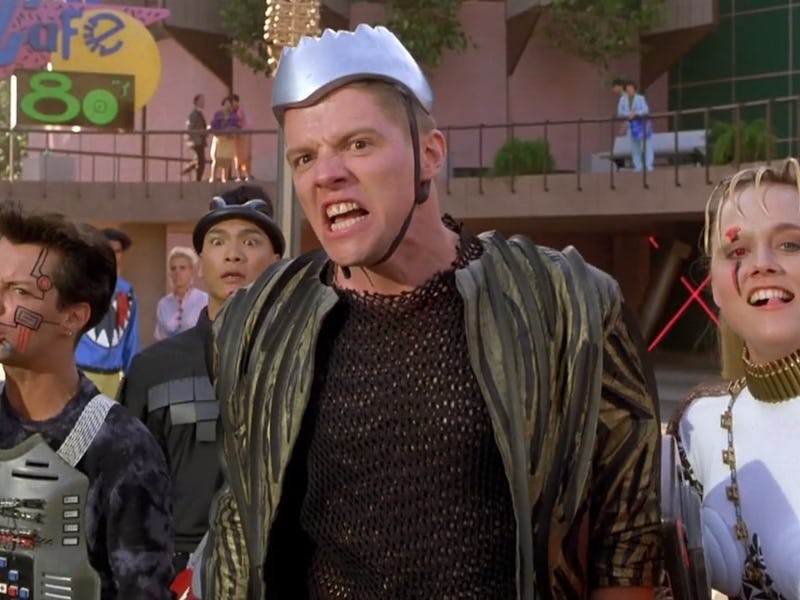How a Classic Sci-Fi Movie Changed the Future By Trying to Predict It
Meet me at Cafe 80s.

“Where we’re going, we don’t need roads.” That’s what Doctor Emmett Brown declares when he and Marty McFly drove his time-traveling DeLorean into the bright future of October 21st, 2015. Back to the Future: Part II, the middle section of perhaps the greatest trilogy in Hollywood history, brought audiences into a new age 30 years ahead of its starting point of 1985. In the grand tradition of cinema trying to predict the future, director Robert Zemeckis didn’t get everything right, but Marty’s 2015 wasn’t entirely unlike the one we eventually actually got, either.
In the 2015 of Back to the Future 2, Marty is forced to fix his kids’ mistakes so their lives won’t be ruined before any of that can happen (just go with it). The Hill Valley of this time is a blend of cyberpunk, retrofuturism, and knowing silliness. Yes, there are flying cars and hoverboards, but there are also projected advertisements and power-laced sneakers. Jaws 19 is playing at the cinema (directed by nepo baby Max Spielberg). Billboards herald the beauty of a surfing vacation in Vietnam. It’s the kind of place you’d love to hang out — if only to check out the self-drying jackets.
Marty and Doc Brown arrive in the future: October 21, 2015.
Zemeckis wasn’t trying to be accurate about the possible future of the 2010s. On the Q&A commentary for the film's DVD release, he said, “For me, filming the future scenes of the movie was the least enjoyable of making the whole trilogy because I don't really like films that try and predict the future ... So, rather than trying to make a scientifically sound prediction that we were probably going to get wrong anyway, we figured, let's just make it funny.” That meant flying cars were a must because who wouldn’t want one of those? (Even though Zemeckis knew they were unfeasible.) It also led to some outlandish fashion, like Doc’s transparent plastic tie.
One of the best side-gags, however, did come true. In one scene, Marty is flabbergasted to discover that the Chicago Cubs won the World Series, a joke rooted in the fact that the real-life team was infamously “cursed” to never make the playoffs. The joke’s on us because, in the actual 2015 season, the Cubs qualified for the postseason and then won the entire series the following year. The official Back to the Future Twitter account even acknowledged the event and blamed a rift in the space-time continuum.
We didn’t get flying cars but we did get hoverboards, albeit way less interesting ones than what Marty used. We also have flat-screen TVs, video chat systems, fingerprint scanning for security access, hands-free video games, and drone cameras. The film even inspired some technological advancements. Marty's impeccably cool "Air Mag" Nikes, with automatic shoelaces, were created by the company in the late 2000s. Nike released HyperAdapt 1.0, the first self-lacing shoe made for retail, in 2017, but they were only available in limited quantities and sold for $720.
Did Back to the Future 2 predict nepo babies?
If there’s one thing that Back to the Future 2 nailed about our present, it’s our nostalgic love of the 1980s. Marty goes to Café ‘80s as part of the set-up with Biff Tannen’s brutish grandson. “It’s one of those nostalgia places but not done very well,” says Doc. He's not wrong. The neon colors are straight out of Miami Vice, “Beat It” is playing on the jukebox, and Marty orders a drink from a robotic Ronald Reagan waiter screen (who then gets into a fight with Ayatollah Khomeini over what Marty should buy). A Pepsi costs $50. Café 80s is to the 1980s what the Mel’s Diner at Universal Studios is to the 1950s: a cleaned-up aesthetic-driven view of the decade from people who didn’t live it. The 30-year nostalgia cycle is a thing (and partly the reason the first movie’s jaunt to the past took Marty to the ’50s), and we were definitely thinking longingly about ‘80s pop culture by 2015 — just one year later, Stranger Things burst onto the scene one year later and we got our first new Ghostbusters movie since 1989.
Pop culture’s ability to predict the future is somewhat overstated. A lot of sci-fi writers rooted their predictions in the growing advancements of their time, while many creators were inspired by their favorite books and movies to recreate the imagined futures of their childhoods. Would Nike have created auto-laced trainers had Marty not worn them in Back to the Future 2? It seems unlikely. But the future of BTTF was so breezy and un-dystopian that it’s no wonder it endured so long in our imaginations (although a world where lawyers were abolished and someone can be jailed and then sentenced to 20 years in prison in two hours is undeniably hellish). 2015 came and went and our future isn’t unlike Marty’s — just with hideous Cybertrucks, endless movie sequels, and Gen Z-ers being into ‘90s fashion). Still, it would have been nice if we’d gotten real hoverboards.